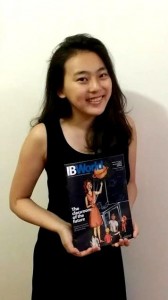IB World magazine talks to Susan Park, IB Diploma Programme student and the winning illustrator of the September 2015 issue’s front cover
When we launched our competition to find the front cover for the September ‘15 issue, we knew students’ depictions of the classroom of the future would be both creative and imaginative.
Having said that, we were still amazed by the entries we received. After several impassioned debates among the editorial team, we decided that Susan Park, IB Diploma Programme student at Discovery College, Hong Kong, would be our winner.
Her illustration shows a teacher using an advanced version of a ‘3D holographic interactive projector’ as a learning tool. The projector allows students and teachers to visually experience and simulate places, structures and topics from past, present and future, all within their classroom environment.
Susan, the artist
Although Susan has always enjoyed drawing, it transpires that we might also have Susan’s art teacher, Fiona Altoft, to thank for our beautiful cover image. “My art teacher saw the competition on social media and sent me a message with the information,” explains Susan. “I was already doing another illustration for my school’s TEDed club, and she thought that I could adapt that style to the competition. It was nearing the summer and I had some free time so I thought, ‘Why not?’”
Susan thought long and hard about what the classroom would look like in 2030. She contemplated how her own classrooms had changed over time, particularly how technology was altering the world around her.
I feel things are slowly transforming from two-dimensional to three-dimensional. You see advertisements, sci-fi movies and other media suggesting holographic developments in the technology of the future. I felt this trend would eventually affect classrooms.
Technology also influenced Susan’s artistic approach. “I used a drawing app, Sketchbook, on my dad’s Samsung Galaxy smartphone before transferring the image to my laptop to lay it out on an app called ‘pages’,” she says. “I also used a cross-hatching technique to create the shadows and then used the layering tool on the app to adjust the colouring and tone.”
Future predictions
Although Susan believes teachers will soon be able to take students on a virtual journey, she doesn’t think there will be drastic changes to the classroom over the next 15 years. “I definitely feel there will be improvements to technological devices and software for learning and communication,” she says. “I predict more and more countries will start incorporating more technological applications to their school environments and start introducing them to students earlier on in their education.”
Sharing the view of many of the contributors we interviewed for the issue, Susan stresses that education technology isn’t just for ‘fun’ but makes teaching more efficient. “Projectors, laptops, interactive whiteboards – they’ve all helped to make the process of learning interactive, visual and easier for both students and teachers,” she says. “It also makes feedback and communication between students and teachers more convenient, but there will always be the pros and the cons.”
And, if Susan achieves her dreams, she’ll be in the classroom to see if it comes true: “I hope to be a teacher one day. I love working with students. By 2030, I hope that I will be a DP teacher at an IB World School, teaching students a subject I’m passionate about.”
To see all the fantastic submissions we received, please visit our Instagram page: instagram.com/IBWorldMag
You can read the latest edition of IB World magazine at http://ow.ly/UNowW


